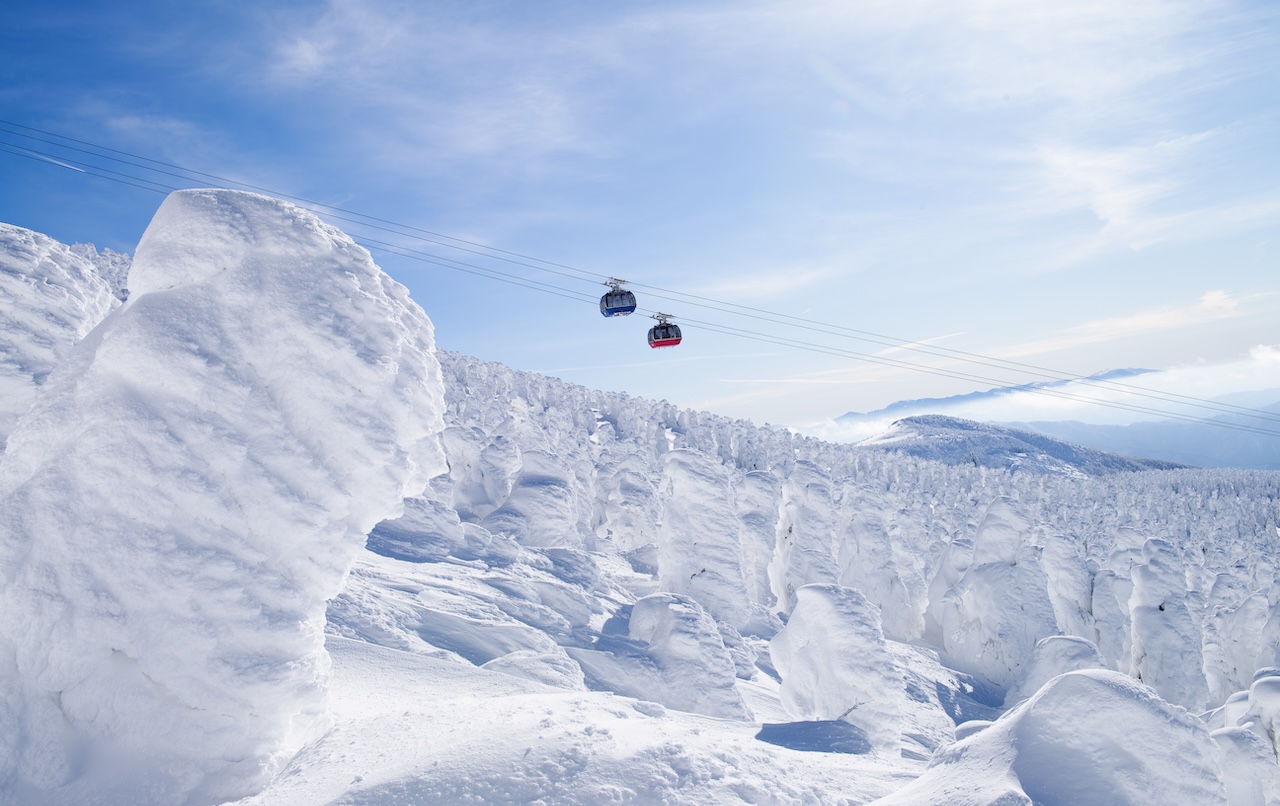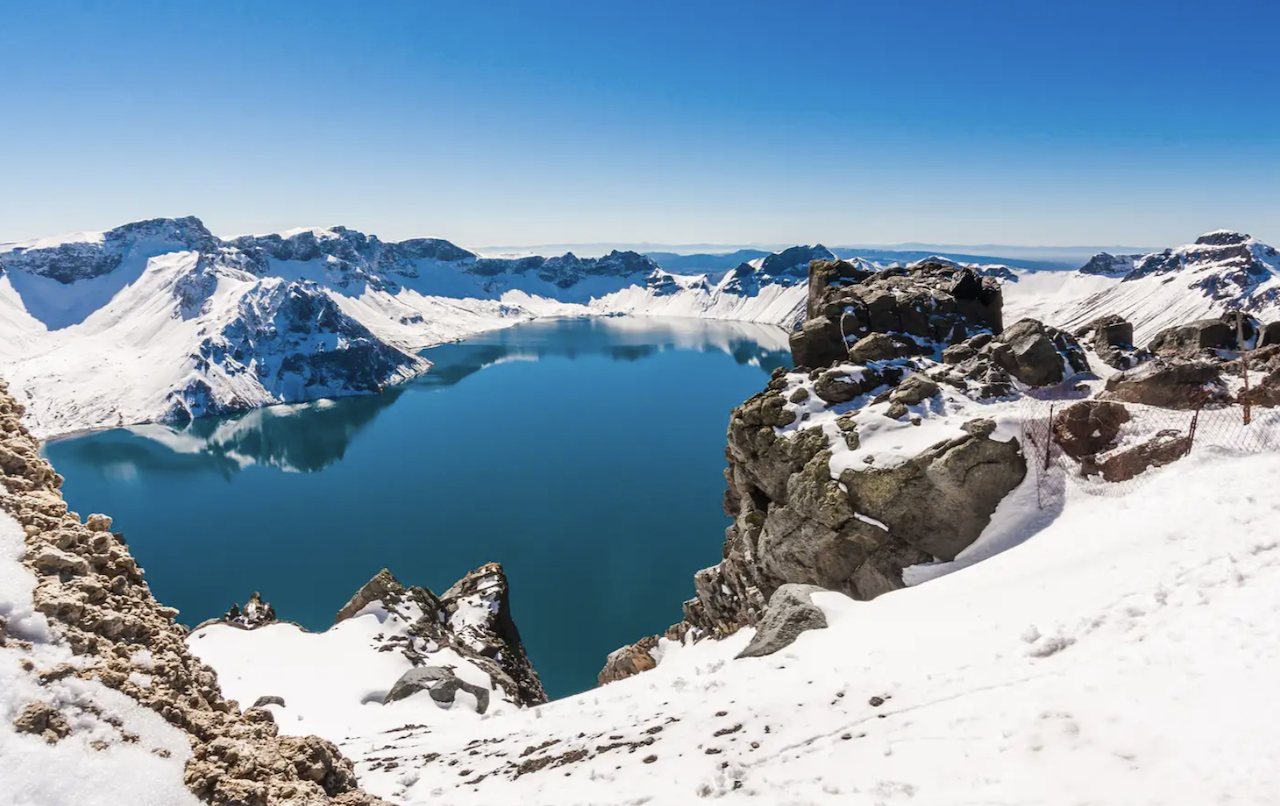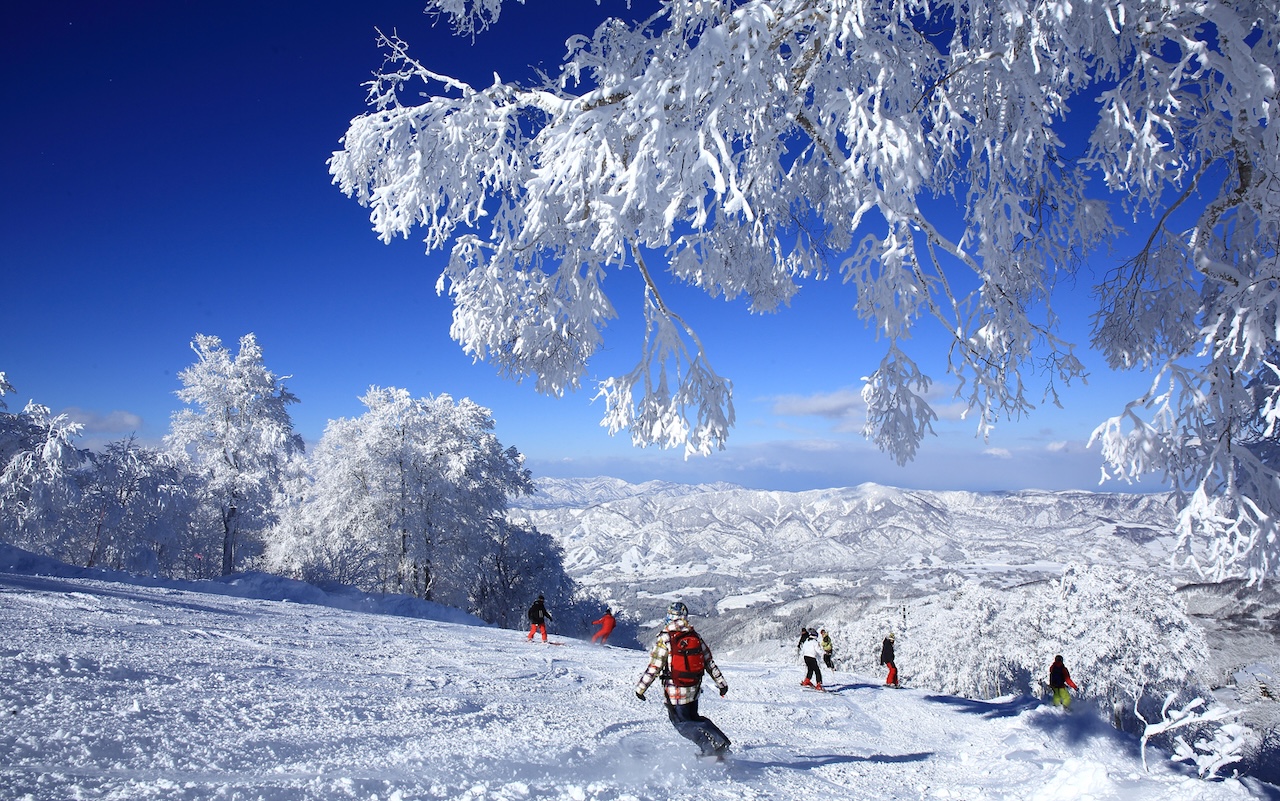Ski season will soon be upon us which means thrilling snow adventures await in some of Asia’s most wintery locales. While some of these places require a bit of travelling, the pay-off is definitely worth it. Expect less crowds and a more culturally immersive experience at these eight lesser-known destinations where you can experience the thrill of the slopes (and possibly relax your muscles in a hot spring after).
Zao Onsen, Honshu, Japan
Good for… snow monsters!
On the slopes: Due to its location in the north of Japan’s main island, Zao Onsen enjoys a similar abundance of snow to Hokkaido, earlier than its southern counterparts on Honshu. There are 25 trails of mixed terrains, with the longest run being over 9km long. The snow monsters (juhyō), or frost covered fir trees at the top of Mount Zao are now becoming a major draw, and if not skiing, tourists can experience the awe-inspiring landscape via gondola, or stop at Jizo Sancho Station to walk amongst them. A good mix of alpine hotels and pensions are available.

Off the slopes: The Tohoku region is not as widely touristed as some other parts of Japan, so it retains an authentic old-school charm. When not skiing, onsen-hop and immerse yourself in the local town and culture.
During the winter, dedicated buses run from Tokyo but can take up to seven hours. Instead, jump on a bullet train followed by a bus to arrive in just over three.
Changbaishan, Jilin, China
Good for… a shiny international ski experience with stunning views
On the slopes: A UNESCO Global Geopark, Changbaishan is a ski region that ticks all the boxes and is gaining popularity with both the local and international set. Long winters and heavy snowfall offer the perfect conditions to explore the variety of trails, with great family areas, intermediate groomed and tree runs, and some advanced options. The integrated modern resort offers a slew of ski-in, ski-out international brand hotels, from family-friendly Club Med to luxurious Park Hyatt.

Off the slopes: Heavenly Lake (Tianchi) is a spectacular crater lake at high elevation, all the more dramatic to marvel at when frozen in winter. There’s also Changbai Waterfall, adding to breathtaking scenery of this mountainous region. Guided snow activities such as snowshoeing and cultural experiences are also easily accessible, and for post-ski fun, Wanda Changbaishan offers plenty of distractions, from shopping to hot springs.
Getting there will require a flight into Bejing and a domestic flight that takes about two hours to Baishan Airport.
Nozawa Onsen, Honshu, Japan
Good for… an authentic and old-school Japanese ski experience
On the slopes: Nozawa Onsen is located in the northern part of Nagano Prefecture, the region known for hosting the 1998 Winter Olympics. Of these areas, Hakuba is the most popular, while Nozawa Onsen possesses a more relaxed and authentic ski village vibe. Over 30 runs and nearly 300ha of skiable area offer a healthy mix of beginner, intermediate and expert slopes, keeping mixed-ability groups happy. Deep snow runs flow straight into the heart of the village, offering a rare ski-to-town experience.

Off the slopes: The village is picturesque, with Edo period architecture and a long history of onsen culture. Sink into the culture through the rustic wooden soto-yu, or public bath houses – the perfect post-ski activity.
Nozawa Onsen is easy to reach from major cities like Tokyo and Osaka by a combination of Shinkansen and bus. In the winter there are also dedicated buses that run out of these cities for a more direct route.
Muju-gun, Jeollabuk-do, South Korea
Good for… nature buffs
On the slopes: South Korea’s only ski resort located in a national park, Muju-gun is less crowded than Vivaldi Park and Yongpyong, and more moderate in size. At 1,530m, it hosts one of the largest commercial vertical drops in the country, along with 15 lifts and up to 35 runs. There’s a good mix of terrain for beginners and intermediate skiers, but Muju-gun is also popular with advanced riders. Different accommodation options include Hotel Tirol within Muju Deogyusan Resort, as well as pensions and guesthouses to suit every type of traveller.

Off the slopes: Take the gondola up to Seolcheon Peak for dramatic alpine views of the national park in winter. From Bandi Land to the Jeoksangsanseong Fortress and Meoru Wine Cave, there’s plenty to explore in the surrounding area.
To get there, fly into Seoul and take a high-speed train to Daejeon followed by a bus to Muju. The journey should take approximately two and a half hours. Another option is to take a three-and-a-half hour drive, which also makes it easy to get around Muju with its limited public transport options.
Sahoro, Hokkaido, Japan
Good for… families
On the slopes: Sahoro Ski Resort in central Hokkaido is great if you want an alternative to the crowded ski spots on Japan’s northernmost island, but don’t want to compromise on quality of snow. The crowd is more local and family-friendly, and eight lifts serve 21 mixed terrain courses, 75 per cent of which are beginner and intermediate. There’s Club Med Sahoro for the all-inclusive ski holiday, or Sahoro Resort Hotel for local flavour, both are ski-in, ski-out. A smattering of ryokan and self-catering stays also dot the area.

Off the slopes: Brown bear observation tours offer the opportunity to view these wild creatures in hibernation, an experience unique to this area.
Sahoro is easy to reach from Sapporo as many of the resorts provide transfers that take just under three hours. Taxis also operate on a flat fee from the city out to the resort.
Chengdu, Sichuan, China
Good for … a quick ski break
On the slopes: It’s not every day that you get the chance to ski in giant panda country. But on Xiling Snow Mountain, just outside the city of Chengdu, you can do just that. The mountaintop is covered in snow all-year round, but mid-December to March sees the best skiing conditions. Take your pick from seven trails of varying difficulties, which add up to 10km of runs. There are domestic hotel brands and guesthouses to choose from, or the full-service Anantara to splash out at, and while there are fewer international tourists here than at ski resorts up north, local traffic is high on weekends and domestic holiday periods, so check before you travel.

Off the slopes: While the non-ski days away with tubing, sledding or snowmobiling in the snow park, or soothe tired muscles in the mineral-rich hot springs which dot the area.
To get to the mountain, buses run from Chengdu and take about three hours. Or cut that down to two and a half hours by taking a private car.
Hiroshima, Honshu, Japan
Good for… a truly local Japanese ski experience
On the slopes: Ideal for all ages and abilities, the Osorakan Snow Park in Hiroshima is one of the largest skiing destinations in western Japan. While modest in size compared to its northern counterparts, there’s a great variety of terrain at this resort, from the gentle beginner zone to slow, lazy declines; hair-raising long runs and exhilarating forest trails. Mount Osorakan is the highest peak in Hiroshima Prefecture, allowing for better snow and better views – on clear days you can even see the Sea of Japan from the summit.

Off the slopes: Sample regional Hiroshima dishes and mountain produce, visit rural historic villages or simply stay within the Family Plaza and have a fun-filled day tubing, sledding and snow rafting.
From Hiroshima, take an hour-long bus ride into Akiota Town followed by a free shuttle bus run by the resort. Hiroshima is easy to reach with the Shinkansen from both Osaka and Tokyo.
Elysian Gangchon, Gangwon-do, South Korea
Good for … a quick ski getaway near Seoul
On the slopes: Combine your South Korean trip with skiing at Elysian Gangchon Ski Resort, a small, modern resort northeast of Seoul. Besides being the only ski resort accessible by subway from Seoul, it is compact, family-friendly and ideal for quick trips for beginner and intermediate skiers. Rental gear is available, so you won’t need to worry about over-packing for city and ski.

Off the slopes: Indulge in the local cuisine, wander the scenic Bukhangang riverside or visit Nami Island – a small, crescent-shaped island in the middle of the Bukhangang River, where scenes from the 2002 Korean hit Winter Sonata were filmed. The island is extremely picturesque – beautifully landscaped and famous for its tree-lined avenues and art installations.
It’s easy to reach the resort from Seoul by taking a train from Cheongnyangni Station to Baegyang-ri Station, which takes an hour and 20 minutes. From there, a free shuttle bus will take you to the resort.
SEE ALSO: Beyond the slopes: Activities to enjoy at some of the world’s best ski resorts
This article was originally written by Crystal Wilde for the January 2018 issue of Silkwinds magazine and has been updated by Aja Ng in November 2025.
For more information on Singapore Airlines’ flights to the above destinations, visit singaporeair.com.


